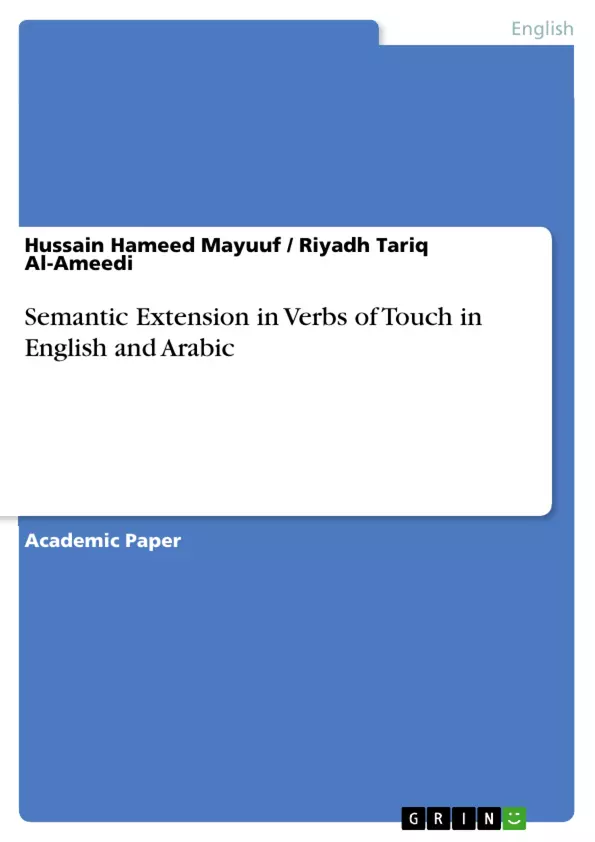This paper deals with the semantic extensions of verbs of touch in English and Arabic. Verbs of touch, as one type of verbs of sensation, are extended metaphorically in a variety of ways that is different from one language to another. Culture is assumed to strongly influence the semantic extensions of verbs of sensation in general and those of touch in particular. This study comes out with a conclusion that this type of verbs are extended semantically to cover a variety of meanings in both languages, English and Arabic.
Table of Contents
- 1. Semantic Classification
Objectives and Key Themes
This paper investigates the semantic extensions of verbs of touch in English and Arabic, exploring how these verbs, as a type of sensory verb, metaphorically expand their meanings across languages. The study examines the influence of culture on these semantic extensions and concludes that verbs of touch exhibit a wide range of meanings in both English and Arabic.
- Semantic extensions of verbs of touch
- Cross-linguistic comparison (English and Arabic)
- Influence of culture on semantic extension
- Categorization of verbs of touch
- Metaphorical meanings of touch verbs
Chapter Summaries
1. Semantic Classification: This chapter provides a detailed classification of verbs of touch within the broader category of verbs of sensation. It distinguishes three main types: "receiving of an expression by the senses independently of the will," "active perception verbs" (consciously controlled), and "flip verbs" (where the stimulus is the subject). The chapter uses examples and references to linguistic theories (Poutsma, Viberg, Rogers, Leech, Gisborne) to illustrate these categories and the criteria for differentiation. A table presents a basic paradigm of verbs of sensation across different sense modalities (vision, hearing, touch, smell, taste), highlighting the variations in lexical items and the concept of "prototype" meaning within semantic categorization. The chapter further explores the prototypical meanings and semantic extensions (physical and metaphorical) of these verbs, emphasizing the close connection between the sense of touch and emotional feeling, supported by insights from Sweetser and Johansen. The chapter lays the groundwork for understanding the nuanced complexities of semantic extension in verbs of touch, particularly in relation to their metaphorical potential.
Keywords
Verbs of touch, semantic extension, metaphor, cross-linguistic comparison, English, Arabic, culture, sensation, perception, prototype, semantic classification, emotional feeling.
Frequently Asked Questions: A Comprehensive Language Preview
What is the main topic of this paper?
This paper investigates the semantic extensions of verbs of touch in English and Arabic, exploring how these verbs metaphorically expand their meanings across languages and how culture influences these extensions.
What are the key themes explored in the paper?
The key themes include: semantic extensions of verbs of touch; cross-linguistic comparison (English and Arabic); the influence of culture on semantic extension; categorization of verbs of touch; and the metaphorical meanings of touch verbs.
How are verbs of touch classified in the paper?
The paper classifies verbs of touch within verbs of sensation, distinguishing three main types: "receiving of an expression by the senses independently of the will," "active perception verbs" (consciously controlled), and "flip verbs" (where the stimulus is the subject). The classification uses examples and references to linguistic theories (Poutsma, Viberg, Rogers, Leech, Gisborne).
What is the role of prototypes in the semantic classification?
The paper explores the prototypical meanings and semantic extensions (physical and metaphorical) of verbs of touch, highlighting the close connection between touch and emotional feeling and using the concept of "prototype" meaning within semantic categorization. A table comparing verbs of sensation across different modalities illustrates this.
What is the significance of cross-linguistic comparison in this study?
The cross-linguistic comparison between English and Arabic allows for an examination of how cultural factors influence the semantic extension of verbs of touch. It investigates whether the metaphorical expansions of these verbs are consistent or vary across these two languages.
What is the connection between touch verbs and emotional feeling?
The paper emphasizes the close connection between the sense of touch and emotional feeling, drawing on insights from Sweetser and Johansen to support this connection in understanding the semantic extension of touch verbs.
What are the key chapters covered in this preview?
This preview includes a table of contents, objectives and key themes, chapter summaries (specifically focusing on the "Semantic Classification" chapter), and keywords.
What are the keywords associated with this paper?
Keywords include: Verbs of touch, semantic extension, metaphor, cross-linguistic comparison, English, Arabic, culture, sensation, perception, prototype, semantic classification, emotional feeling.
What linguistic theories are referenced in the paper?
The paper references linguistic theories from scholars such as Poutsma, Viberg, Rogers, Leech, Gisborne, Sweetser, and Johansen to support its analysis and classification of verbs of touch.
What type of verbs are analyzed in this paper?
The paper focuses specifically on verbs of touch, a subcategory of sensory verbs.
- Quote paper
- Hussain Hameed Mayuuf (Author), Riyadh Tariq Al-Ameedi (Author), 2021, Semantic Extension in Verbs of Touch in English and Arabic, Munich, GRIN Verlag, https://www.grin.com/document/998243



